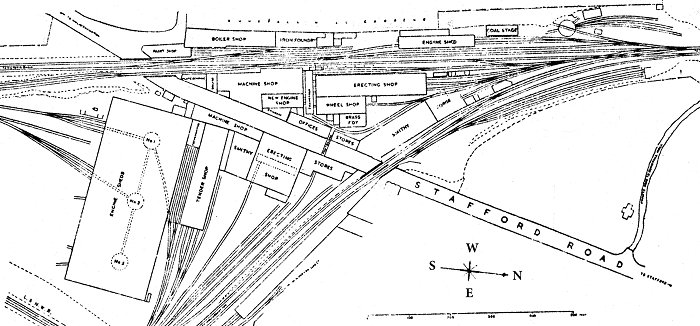
Stafford Road Works and running
sheds in 1875, after the provision of turntable sheds
Nos 2 and 3. Rapid expansion of the old S&B (upper
level) site since 1854 includes a two-road standard
gauge running shed and a coal stage, erected in about
1860 just to the south of Oxley viaduct (out of view to
the north). Once this shed was in use, an erecting shop
was then built on the site of the original, smaller,
S&BR shed near the railway bridge over the Stafford
Road. The 1860 shed was demolished in about 1890, but
the coal stage remained for use by locomotives
terminating at Victoria Basin or at Oxley sidings.
Author's Collection. |
|
It soon became clear in the early
1870s that more covered locomotive accommodation was
urgently required, and two further turntable sheds were
erected alongside shed No 1 in 1874 and 1875. These
housed about 22 and 30 locomotives respectively. These
three sheds were designated as shed Nos 1, 2 and 3, or
were sometimes referred to as 'A', 'B' and 'C'. Any
visitor during the period 1875-85 would have found an
impressive array of both antiquated, rebuilt or
newly-constructed engines on view, ranging from 2-2-2
singles and 2-4-0 passenger engines to 0-6-0 tender
engines and 0-6-0 and 0-4-0 tank engines. Perhaps the
most fascinating period of all at Wolverhampton would
have been from around 1855 up until the turn of the
century.
Joseph Armstrong's last class of
singles were the 'Queen' class 2-2-2s, and No 999 Sir
Alexander was a well-known Stafford Road resident.
Completed at Swindon Works in March 1875, it was rebuilt
at Stafford Road Works in September 1882, with enclosed
wheel splashers, a cab and various typical
Wolverhampton-style fitments, such as a roll-top chimney
and smokebox wing-plates. For many years the 'Queens'
worked express trains from London to Swindon, Gloucester
and Wolverhampton. E. L. Ahrons, writing in Locomotive
and Train Working in the Latter Part of the 19th
Century, tells us that Nos 999, 1000, 1116, 1121 and
1127 were all allocated to Stafford Road shed; No 1126
was also later transferred to the Northern Division.
By 1904 the 'Queens' were largely
relegated to secondary work from Oxford and Swindon,
their reign at Wolverhampton coming to an end when a
longer turntable was installed in one of the sheds, in
about 1900, enabling the larger GWR 4-2-2 locomotives to
work into Wolverhampton. New locomotives continued to
arrive, and by January 1902 eleven Gooch-designed 0-6-0
goods engines had also been allocated. By now Stafford
Road was one of the busiest GWR operating depots in the
country. In view of this situation a decision was taken
to erect another shed, mainly for goods locomotives,
over on the north side of the Oxley viaduct, overlooking
Dunstall Park racecourse. This new 'Oxley' shed was
opened on 1 July 1907. Both sheds were then operated as
a joint concern, although Oxley had its own integral
coaling bay from new, located in the shed yard.
In the early years at Stafford Road
shed, up until 1869 a coal transfer stage was operated
whereby the coal was unloaded from narrow to broad gauge
wagons from an overhead ramp, for distribution between
the separate sheds. Coaling of locomotives was then
carried out manually from secondary stages, one of which
was in the lower yard adjacent to the broad gauge shed -
this coal stage is clearly shown on an 1867 plan. A
basic hand-operated crane fitted with an adjustable jib
and bucket-style grab was then used to load the coal on
to the locomotives. This situation became increasingly
unsatisfactory and time-consuming and so by 1900 a
purpose-built red-brick coaling plant was erected some
distance away from the locomotive sheds on the opposite
side of the BCN canal. This may well have replaced an
earlier 1850s coaling stage left over from broad gauge
days in the same area. |
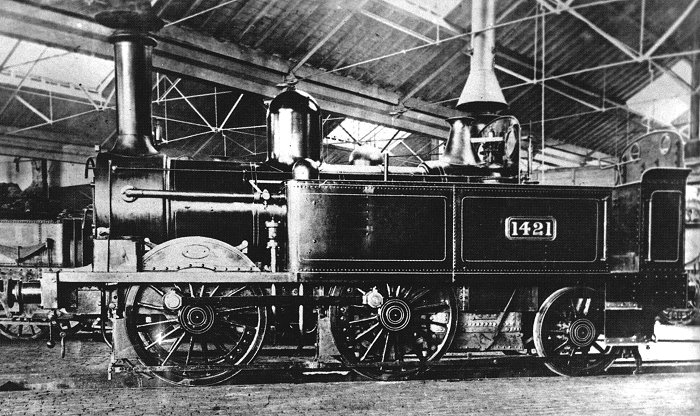
A '517' class 0-4-2T, No 1421, is
at rest inside one of the three large turntable sheds at
Stafford Road circa 1880. It is seen in original
condition, as completed in Wolverhampton as Works No 313
in April 1877. The '517' class had countless variants,
from short-wheelbase saddle tanks through to
long-wheelbase side tanks, and No 1421 differed from its
predecessors in that the wheelbase was 15ft rather than
13ft 7in, and the dome had a tall brass cover. It was
the 109th member of the class and eventually the fleet
numbered 156, all erected at Stafford Road Works between
1868 and 1885. The '517s' were often used on suburban
work in the Wolverhampton and Birmingham areas, this
particular example eventually being withdrawn from
service in 1928. Author's Collection. |
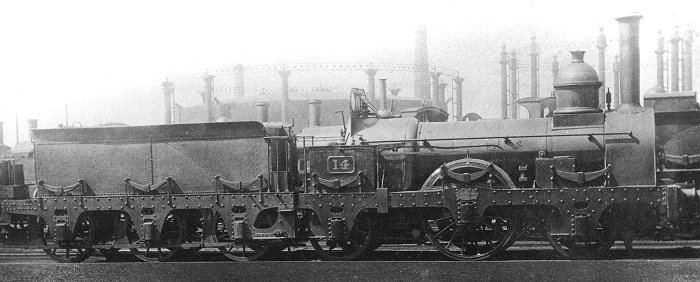
A survivor from the S&CR's 1854
amalgamation with the GWR, 1848-built 2-2-2 No 14, is
seen in the Stafford Road shed yard circa 1890. Legend
has it that this engine was a favourite of CME George
Armstrong during his own locomotive driving days, and
because of this it was kept until 1920, minus its
tender, despite being officially withdrawn in December
1885. It could be seen during this period inside the
shed building, standing on two carefully placed lengths
of old bridge rail, and was supposedly repainted on one
side only for photographic purposes. Despite an
assumption in a GWR Magazine article that it was
destined for preservation, it was scrapped after 35
years of safe keeping, on the personal orders of
Benjamin Giles, the Works Superintendent. He may have
had some explaining to do when a request was received
from Swindon to prepare the engine to take part in the
1925 railway celebrations! The tender attached to the
engine in this view is not the original. Author's
Collection. |
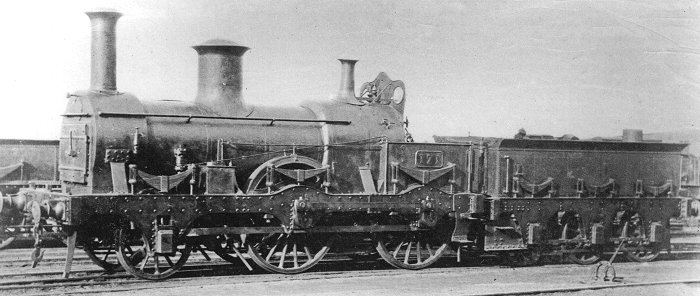
Former OW&WR No 1 in its later
guise as GWR No 171 in Stafford Road yard circa 1880.
This 2-4-0 was built by R. & W. Hawthorn in 1852 and it
became a West Midland Railway asset on 1 July 1860. In
turn it became GWR property from 1 August 1863, with
another amalgamation, along with 130 other WMR
locomotives. Although receiving minor modifications at
Stafford Road Works over the years, No 171 would be
withdrawn in July 1885 without being rebuilt. Author's
Collection. |
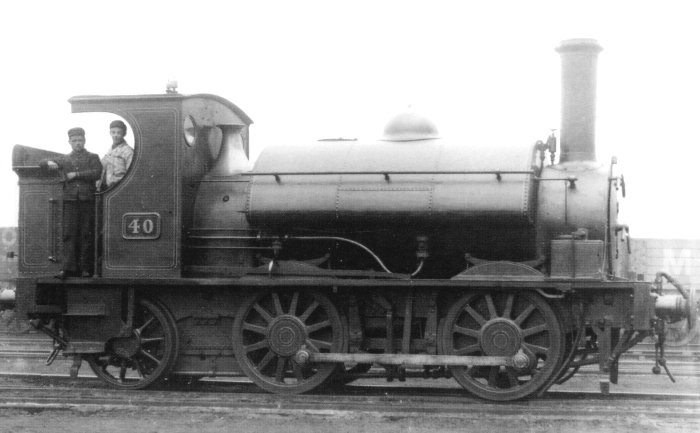
A circa 1880 scene at Stafford
Road, GWR No 40 - its heritage harks back to Shrewsbury
& Birmingham Railway No 6. An 0-4-2 tender engine with
single frames, outside-cylinders, a long boiler and
Gothic firebox, it was built by R. B. Longridge and
delivered in February 1849. ln September 1852 the S&BR
put it up for sale but No 6 was still in stock when the
GWR took over in September 1854. Taken out of use in
June 1858, the engine was then completely rebuilt at
Wolverhampton, emerging in March 1862 as an 0-4-2ST;
Ahrons stated that it 'contained nothing of the original
engine'. This view records it after an '850' class
boiler was added in October 1873, and a subsequent
rebuild in 1897 would see it through to withdrawal in
1904. Author's Collection. |
| A circa 1885 view finds
'Queen' class 2-2-2 No 999 Sir Alexander in the
Stafford Road shed yard. Dating from March 1875,
this express passenger engine is seen after its
September 1882 rebuild at the nearby Stafford Road
Works. Sir Alexander was named after Sir Charles
Alexander Wood, a Director of the GWR from 1863 to
1890. This Single was eventually withdrawn from
service in October 1904, but at least one of its
nameplates has survived and is now on show at the
Kidderminster Railway Museum. Author's Collection. |
|
An 1867
plan records the lower yard's 1857-built four-road
broad gauge engine shed and turntable (centre
right), together with the coal transfer stage (upper
left), and some of the ex-S&BR (High Level) site
facilities on the opposite side of the Stafford
Road.
The
transfer stage was located close to the GWR's mixed
gauge main line, near the gasworks yard and close to
where the Dunstall Park station platforms would be
located from 1896.
Coal
transfer was carried out using two standard gauge
tracks that ran onto an elevated platform positioned
above two broad gauge tracks.
Most
probably, the coal was then either shovelled, or
perhaps dropped by gravity from one coal wagon to
another for further distribution. It is assumed that
the coal stage fell into disuse by 1870, after the
end of broad gauge operations at Wolverhampton,
although no specific information confirms when it
was finally removed. Author's Collection.
|
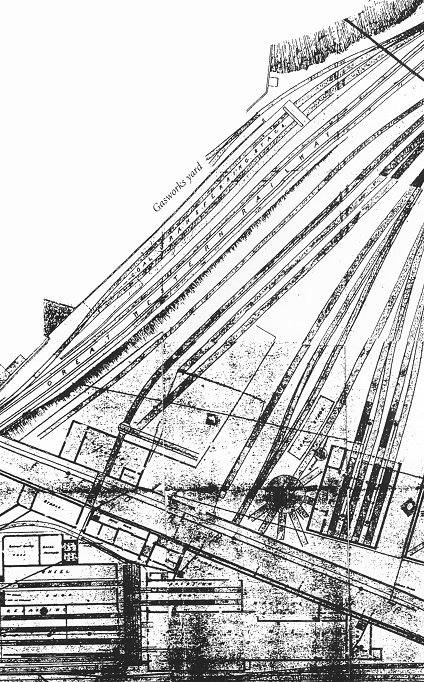 |
|
Also at the south end of the new
coaling plant yard was a 65ft turntable and an oil-gas
manufacturing plant. These buildings were all demolished
following the closure of the sheds in 1963, the last
remains being swept away in about 1985. However, at the
time of writing the circular turntable hollow still
remains visible, together with some of the perimeter
brickwork. These last few remains of the coaling bay
infrastructure have been included in The Wolverhampton
City Council Lock Conservation Area appraisal document
issued in May 2013, as being of archaeological
potential.
Some Stafford Road locomotives got
VIP treatment. Writing in Locomotive Adventure, H.
Holcroft recalls that (circa 1898) 'one could see an old
single-wheeler moving out of the gloom of the shed into
the daylight with cleaner lads clinging on to it in
order to put the finishing touches to the gleaming paint
and shining brass. So keen were these lads that they had
to be removed so as to enable the engine to depart'.
Things would be very different as regards locomotive
cleaning in the years just prior to closure.
As from around 1904, the '4400' and
'4500' 2-6-2Ts started to appear, the first batches
having been built at Stafford Road Works until such time
as construction was transferred to Swindon in 1909.
Large numbers of 0-6-0STs and '517' class 0-4-2Ts were
also now being built at Stafford Road Works and they
were often seen in the shed yard. Tank engines in
general were, of course, always a regular sight on shed,
right up until closure.
With the outbreak of World War 1
only a few months away, the following 'modern' passenger
locomotives were noted at Stafford Road shed in the
autumn of 1913 – French- built De Glehn Compound 4-4-2
No 104 Alliance, together with 'Saint' class 4-6-0s Nos
2901 Lady Superior, 2902 Lady of the Lake, 2905 Lady
Macbeth, 2906 Lady of Lynn, 2908 Lady of Quality, 2909
Lady of Provence, 2910 Lady of Shallot, 2911 Saint
Agatha and 2949 Stanford Court, and four-cylinder 'Star'
class 4-6-0s Nos 4004 Morning Star, 4034 Queen Adelaide
and 4036 Queen Elizabeth. |
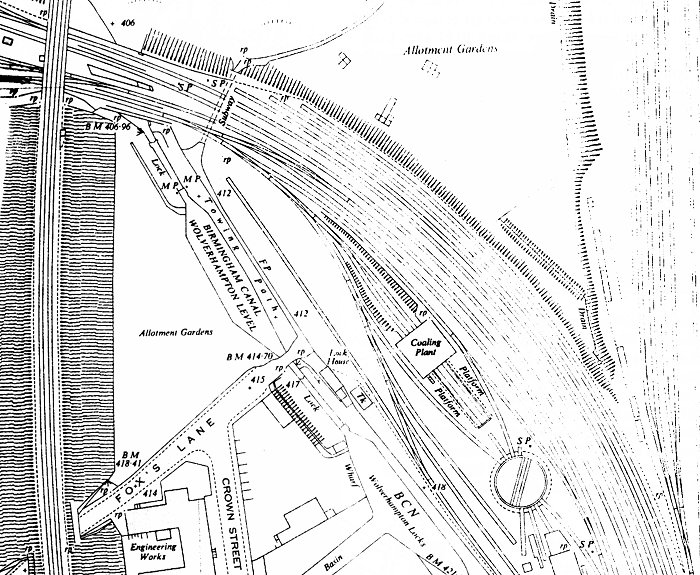
A late 1930s Ordnance Survey plan
shows the separate Stafford Road shed coaling plant
erected circa 1900 on land adjacent to the BCN waterway.
South of the turntable is an oil-gas manufacturing
plant. In the top left-hand corner is the exit from the
lower shed yard, beneath one of the arches of the LMS
Stour Valley line viaduct, with the GWR main line
through the neighbouring arch, heading south-east from
Dunstall Park station and skirting the shed lines as it
makes for Wolverhampton (Low Level). The lines heading
south to north on the far right of the map are those of
the GWR link from S&B, or Cannock Road, Junction through
to the LMS at Bushbury. Courtesy Ordnance Survey
Historical Map Archive. |
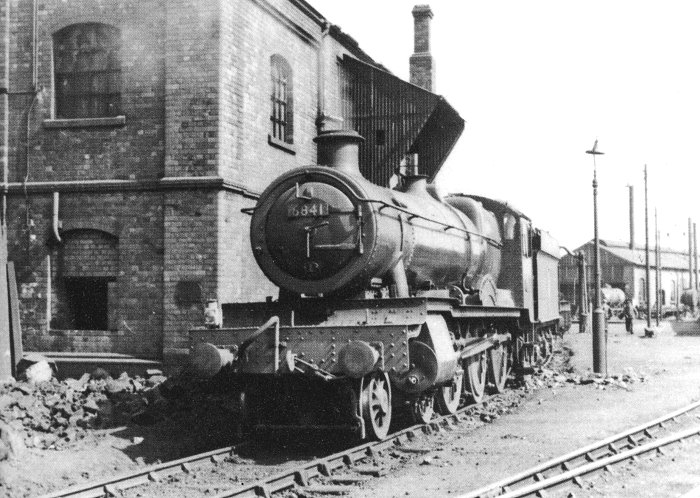
Collett 'Grange' class 4-6-0 No
6841 Marlas Grange is at the Stafford Road coaling plant
in the early 1960s, a location known on early plans as
the 'oil-gas yard'. The oil-gas manufacturing plant
building is seen in the background, complete with an oil
wagon outside. Note the stationery boilers (with twin
tall chimneys) visible on the extreme right - they were
used in the manufacture of the oil-gas. From here, the
oil-gas was pumped to a pair of storage tanks located
just to the south side of Wolverhampton (Low Level)
station, where it was transferred to coaching stock
undergoing servicing at the carriage sheds to the rear
of the station. Author's Collection. |
|
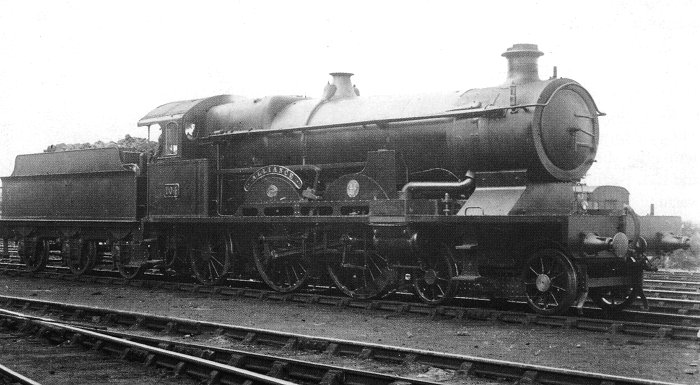
French-built De Glehn Compound No 104 Alliance is at
Stafford Road's coaling plant on 19 July 1924. Taken
into GWR stock during 1903 and 1905 for evaluation, this
class of three 4-4-2s was initially put to use on West
of England expresses. However, in about 1907 they were
sent north to work the Wolverhampton and Worcester
trains, so Nos 102 La France, 103 President and 104
Alliance were allocated to Stafford Road shed until
around 1913, when transferred away to Oxford for use on
Birmingham and Wolverhampton trains. Over the years they
all received standard GWR boilers, chimneys and other
fitments, and they were often seen being serviced at
Stafford Road shed. The three engines were eventually
withdrawn between 1926 and 1928 and cut up at Swindon,
although the wheels, most of the frames and the cab of
No 104 lingering on in the scrapyard well into 1930.
Author's Collection. |
 |
|
 |
Return to
the beginning |
|
Proceed to
part 3 |
|